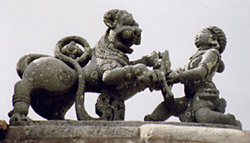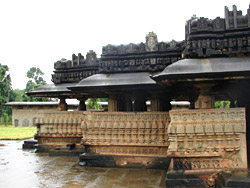 The Hoysala Empire was situated in the south of India and they were really prominent at that period of time. They ruled between the 10th and the 14th centuries. The Hoysala rulers rose to power by taking advantage of the conflicting western Chalukyas and Kalachuri kingdoms. They annexed the fertile areas of Kaveri river and present day Karnataka region.
The Hoysala Empire was situated in the south of India and they were really prominent at that period of time. They ruled between the 10th and the 14th centuries. The Hoysala rulers rose to power by taking advantage of the conflicting western Chalukyas and Kalachuri kingdoms. They annexed the fertile areas of Kaveri river and present day Karnataka region.
Background and History Of Hoysala Empire
The Hoysalas were the descendants of the Yadu and call themselves the Yadavas, which is evident from the inscriptions, dated 1078 and 1090, but no records of it being connected with the Yadavas of North India can be found. The founder of the kingdom was known as Sala, this too originated from a folklore describing a story where a young student, sala was directed by his teacher Sudatta Muni, to smash tiger, where the words hoy and sala meaning strike-sala, where he strikes and kills it. Then he was commanded by the teacher to form a kingdom. The first Hoysala family has the name of Arakalla as the chieftain, which was followed by a series of Hoysala kings. They became a strong subordinate of the Western Chalukyas. The Hoysalas made Kannanur Kuppam their capital and established a complete dominance over the Deccan region. The Hoysala Empire also went through a lot of political upsurges being sacked by the Muslim Sultans.
The Emperors
After Arekalla, the chieftain, Munda (1006-1026) followed him and was was succeeded by Nripa Kama II who was known as Permanadi who had associations with the Western Ganga dynasty. The Hoysala dynasty achieved an eviable position of a `real kingdom` due to the efforts of Vishnuvardhana who had many succesful military conquests attached with his name. His grandson Veera Ballala II, freed the Hoysalas from subordination in 1187. Veera Ballala III was killed at the battle of Madurai in 1343 which marked the end of the Hoysala Empire, merging the self-governing territories of the Hoysala empire with other regions.
Administration
 The Hoysalas inherited the Chalukya framework of administration. The Hoysala Empire was divided into "Nadus, Kampanas, Vishayas and Deshas". Feudatory chiefs called Samantas administered the hereditary feoffs in the empire. `Nadaprabhu`, `Nadagauda` and `Nadasenabhova` were officers in charge of smaller territorial units like Nadus. Each province was governed by a local body headed by a minister(Mahapradhana) and a treasurer (Bhandari) who reported to the ruler of that province, known as Dandanayaka. Dandanayakas were in charge of armies and the Dharmadhikari was the chief justice of the Hoysala court. The local farmers and labourers were hired and supervised by officials called Heggaddes and Gavundas. The village councils functioned actively, and representative idea was prevalent. An official called `Pattanaswami` used to look after the towns; he had both civil and military functions.
The Hoysalas inherited the Chalukya framework of administration. The Hoysala Empire was divided into "Nadus, Kampanas, Vishayas and Deshas". Feudatory chiefs called Samantas administered the hereditary feoffs in the empire. `Nadaprabhu`, `Nadagauda` and `Nadasenabhova` were officers in charge of smaller territorial units like Nadus. Each province was governed by a local body headed by a minister(Mahapradhana) and a treasurer (Bhandari) who reported to the ruler of that province, known as Dandanayaka. Dandanayakas were in charge of armies and the Dharmadhikari was the chief justice of the Hoysala court. The local farmers and labourers were hired and supervised by officials called Heggaddes and Gavundas. The village councils functioned actively, and representative idea was prevalent. An official called `Pattanaswami` used to look after the towns; he had both civil and military functions.
Economy
The Hoysala economy was predominantly agrarian, though there were a few basic industries, which flourished. Traders were organized into guilds, which helped in the promotion of fair trade. The Hoysala empire had trade contacts with Chera, Chola, Pandya, Magadha, Malaya archipelago, Kosala, Persia, Nepahal, Arabia and other countries.
Religion
Prevalence of Hinduism along with Jainism and Buddhism can be spotted instead of a decline in the later two religions due to a rise in Vaishnava Hinduism in the Hoysala empire. Though Jain places of worship could be found in Shravanabelagola and Kambadahalli. Adi Shankara Advaita philosophy resulted in the decline of Buddhism, and the only place of Buddhist worship during this time was at Dambal and Balligavi. Three important religious movements can be spotted during the Hoysala rule which were inspired by three philosophers Basavanna, Madhavacharya and Ramanajacharya. Basavanna preached a faith without a caste system, Madhavacharya established eight Mathas (monastery) in Udupi beleiving in reality of the world and Ramanujacharya preached the way of devotion (bhakti marga) and wrote Sribhashya a critique on the Advaita philosophy.
The Hoysala empire hence was an intense blend of bravery and cultural richness, which is notable among the history of classical India.



















